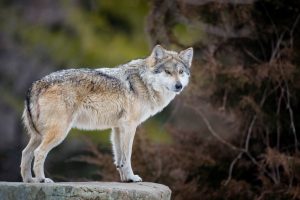Martha Pskowski, El Paso Times

It’s been a long and lonely road for Mr. Goodbar. But the Mexican gray wolf’s GPS collar shows he has recently been traveling alongside a single female wolf.
After nearly being eradicated in the wild, Mexican gray wolves were reintroduced to the Southwest in the 1990s. But the population of the endangered species has been slow to recover: People are known to illegally kill wolves and only about half of pups survive to adulthood. The 2021 census put the wild Mexican gray wolf population in New Mexico and Arizona at 196, but wolves like Mr. Goodbar provide hope that the iconic species of the Southwest will make a full comeback.
Mr. Goodbar paced the border wall in November 2021 and later survived a gunshot wound. Despite these obstacles, the wolf continued to roam in search of his own territory and, hopefully, a mate. Recent tracking information indicates he is traveling with a female wolf named Stella. It’s too soon to know if they will form a pack. But their companionship is an encouraging sign for the endangered wolf.
“I’m delighted that he’s still alive after everything he went through,” said Michael Robinson, senior conservation advocate at the Center for Biological Diversity. “And all the better if he mates and raises pups.”
When Mr. Goodbar met Stella
Mr. Goodbar, identified as M1888 by the U.S. Fish and Wildlife Service, was born at a Kansas zoo in April 2020. He was cross-fostered into the Hoodoo Pack of wolves that spring. As he approached mating age, Mr. Goodbar struck out on his own around October 2021.
Young Mexican gray wolves can cover long distances while seeking their own territory and a mate. This practice is known as dispersing.
In November 2021, Mr. Goodbar’s GPS collar located him along the U.S.-Mexico border wall in Southern New Mexico, where he paced for 23 miles. He eventually turned back north. Sometime in January, he was shot in New Mexico. After his right hind leg was amputated at the ABQ BioPark Zoo in Albuquerque, he was again released into the wild.
Meanwhile, a female wolf was starting her own wanderings. According to quarterly reports from the Mexican Wolf Interagency Field Team, F2694 was born into the Saffel pack in 2021. That November the field team captured her and collared her with a GPS tracker.
Lobos of the Southwest, a coalition of organizations that supports Mexican wolf recovery, held a naming contest for pups born in the wild in 2021. A first-grader nominated the name Stella, which was chosen for F2694.
Stella began dispersing from the Saffel pack in January and by late April the field team considered her a single wolf. She roamed outside the usual wolf range toward Albuquerque. Mr. Goodbar also roamed extensively, including near the town of Magdalena, New Mexico, on U.S. Route 60. Sometime this summer, their paths crossed.
“They say opposites attract. But in this case these are both wolves that are well traveled and have found each other,” Robinson said.
U.S. Fish and Wildlife periodically updates an online map with the approximate locations of collared Mexican gray wolves. The map currently shows Mr. Goodbar and Stella near the Gila National Forest. It remains to be seen if they stick together and eventually form a pack.
ABQ BioPark Zoo head veterinarian Dr. Carol Bradford operated on Mr. Goodbar. At the time, she said wolves are known to survive for years after amputations. But she warned amputation could have affected Mr. Goodbar’s ability to reproduce.
Whether or not Mr. Goodbar and Stella form a pack and raise pups, advocates for Mexican wolf recovery will be cheering them on.
This article originally appeared in the El Paso Times

